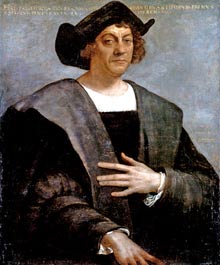Christopher Columbus (1451 – 1506) was an Italian explorer, colonizer, and navigator. He is remembered as the principle discoverer of the Americas and helped bring the Americas to the forefront of the western consciousness. His discoveries and travels laid the framework for the later European colonisation of Latin and North America.
(1451 – 1506) was an Italian explorer, colonizer, and navigator. He is remembered as the principle discoverer of the Americas and helped bring the Americas to the forefront of the western consciousness. His discoveries and travels laid the framework for the later European colonisation of Latin and North America.
 (1451 – 1506) was an Italian explorer, colonizer, and navigator. He is remembered as the principle discoverer of the Americas and helped bring the Americas to the forefront of the western consciousness. His discoveries and travels laid the framework for the later European colonisation of Latin and North America.
(1451 – 1506) was an Italian explorer, colonizer, and navigator. He is remembered as the principle discoverer of the Americas and helped bring the Americas to the forefront of the western consciousness. His discoveries and travels laid the framework for the later European colonisation of Latin and North America.“You can never cross the ocean unless you have the courage to lose sight of the shore.”
– Christopher Columbus
Short bio Christopher Columbus (1451 – 1506)
 Christopher Columbus was born in the Republic of Genoa, in what is today north Western Italy. His father was a middle class wool merchant. Columbus learnt to sail from and early age, and later worked as a business agent, travelling around Europe to England, Ireland and later along the West coast of Africa. He was not a scholar, but was an enthusiastic self-educated man, who read extensively on astronomy, science and navigation. He also became fluent in Latin, Portuguese and Spanish.
Christopher Columbus was born in the Republic of Genoa, in what is today north Western Italy. His father was a middle class wool merchant. Columbus learnt to sail from and early age, and later worked as a business agent, travelling around Europe to England, Ireland and later along the West coast of Africa. He was not a scholar, but was an enthusiastic self-educated man, who read extensively on astronomy, science and navigation. He also became fluent in Latin, Portuguese and Spanish.
Christopher Columbus was a believer in the spherical nature of the world (some Christians still held the view that the world was flat). Though his views on the global nature of the world were not unique. An ambitious man, Christopher Columbus hoped to find a Western approach to the lucrative Spice markets in Asia. Rather than sailing East, he hoped that sailing west would lead to countries like Japan and China.
To gain the necessary funding and support for his journeys, he approached the Catholic Monarchs of Spain. As part of his offer, he said that he hoped to be able to spread Christianity to ‘heathen lands’ in the east. The Spanish monarchs agreed to fund Columbus, partly on the missionary efforts, but also hoping to gain an upper hand in the lucrative trade markets.
Voyages to the Americas
Columbus’ first voyage was completed in 1492, he had intended to sail to Japan, but ended up in the Bahamas, which he named San Salvador.
Columbus made a total four journeys, where he sailed extensively around the Caribbean islands of Cuba, Jamaica, the Bahamas and also to the mainland, to places such as Panama.
Columbus was not the first person to reach America. Previous successful voyages included a Norse expedition led by Leif Ericson. However, Columbus was the first to travel to America and establish permanent settlements. Columbus’ voyages and reports, over the next 400 years, encouraged all the major European powers to seek to colonise parts of America.
As part of the deal, the Spanish monarchy Columbus was appointed Viceroy and Governor of the Indies in the island of Hispaniola. He also delegated the governorship to his brothers. However, in 1500, on the orders of the Spanish monarchy, Columbus was arrested and placed in chains. There were allegations of incompetence, misrule and barbaric practises in the governorship of the new colonies. After several weeks in jail, Columbus and his brothers were released, but Columbus was not allowed to be governor of Hispaniola any more.
Towards the end of his life, Columbus became increasingly religious. In particular, he became fascinated with Biblical prophecies and wrote ‘Book of Prophecies’ (1505)
Columbus died in 1506, aged 54 from a heart attack related to reactive arthritis. Undoubtedly, the rigours of travelling across the seas weighed upon Columbus’ health. Towards the end of his life, he was frequently in pain from his journeys.
Columbus is venerated in America as the man who helped but America on the map. Columbus Day is observed on 12 October in Spain and across the Americas. Others take a more critical view of Columbus pointing to evidence of mistreatment of native Indians, which set the tone for the next several centuries of mistreatment.
EmoticonEmoticon